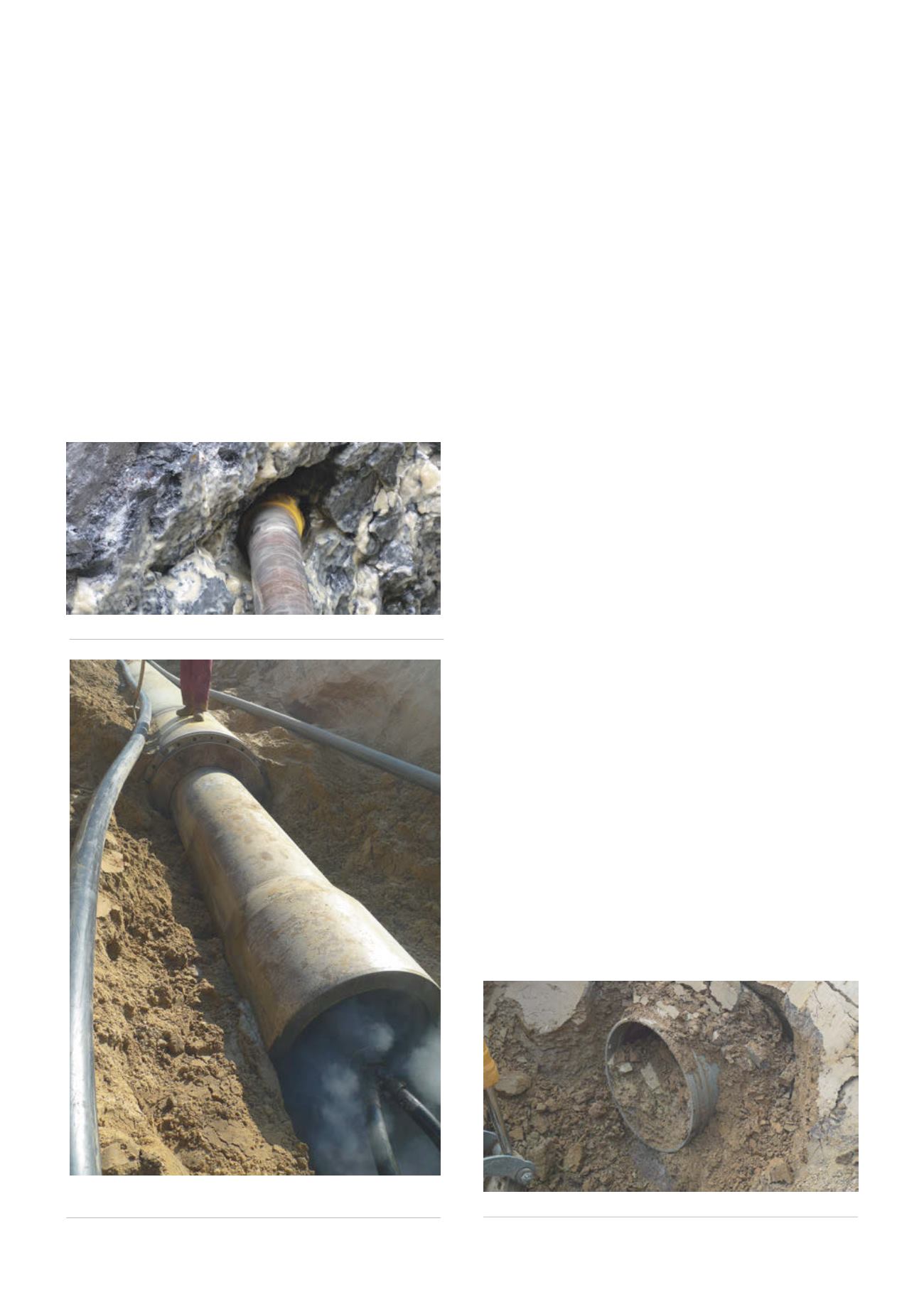
river. During this occurrence, a gas pipeline got damaged that was
provisionally re-directed above ground. Before the onset of winter,
a new gas pipeline had to be installed by means of a trenchless
rock bore.
The jobsite was located in the northernmost section of the
Pennine Hohe Tauern window which, from a geological point
of view, belongs to the so-called ‘ravine lime zone’ with quartz
enclosures of 40% (60 - 150 MPa). As these quartzous enclosures
are very abrasive, extreme wear of the boring tools had to be
expected. A further difficulty was the bore depth of 47 m, which
complicated detection of the cable-guided bore and was yet to be
completed successfully. Moreover, space was extremely limited in
the ravine near the village of Gastein.
Key facts:
)
)
Technique: horizontal directional drilling.
)
)
Type of bore: installation of a gas pipe through rock.
)
)
Equipment: HDD rig GRUNDODRILL 18ACS.
)
)
New pipes: protection pipe ND 355 mm, gas pipe ND 225 mm.
)
)
Bore length: approximately 116 m.
)
)
Bore depth: up to 47 m.
)
)
Upsizing bores: with hole opener 10, 14 and 18 in.
)
)
Soil type: ravine lime with quartz enclosures of 40%
(60 - 150 MPa).
)
)
Client: Salzburger Netz GmbH.
)
)
Contractor: Wadle Bauunternehmung GmbH.
Ramming technology in pipeline construction
When it comes to the installation of pipelines along linear bore
paths, the steel pipe ramming technique is perfectly suitable. The
pneumatically driven GRUNDORAM pipe ramming machines
provide thrust forces up to 40 000 kN (4000 t), enabling the
economic installation of open steel pipes as casing or product
pipes up to 4000 mm dia., over lengths up to 80 m in soil classes
1 - 5 (partly even class 6 – easily soluble rock). The pipe string,
which is welded together beforehand, can be pushed forward with
a propulsion speed of up to 10 m/hr, so that road crossings can be
completed within one working day. The technical and economical
advantages of the ramming technique result from the fact that
neither rear nor front or bottom abutment are required, thus
shortening the set-up times. This technique also ensures that the
pipe string is stably embedded in the ground as the structure of the
surrounding soil is not loosened, this also makes pipe installation
in water-bearing and rocky soils possible. Due to its very small
displacement volume in the area around the cutting shoe, ground
heave can be ruled out even with little cover.
Steel pipe ramming for NEL pipeline
The NEL, North European Natural gas line fromWinGas in Kassel
(Germany), distributes the natural gas arriving from Russia to
Germany and the rest of Northwest Europe. The natural gas
storage unit in Rheden is the final arrival point for the gas pipeline,
which leads all the way from Lubmin. Stretching over the 440 km
path from the north of Germany countless roads, rivers and railway
tracks had to be crossed under.
The contract for two construction packages with a length of
over 120 km was received by Bonatti S.p.A. from Parma in Italy.
A decision was made to apply the dynamic ramming method,
being quicker and less expensive than the auger boring method
combined with a spiral conveyor. Within this framework the Dutch
company DALCAI, a specialised company for horizontal bore
Figure 5.
The glass fibre reinforced steel pipes welded
together forming a pipe string with cutting shoe at the front.
Figure 4.
Start of the bore through the hard limestone.
Figure 6.
Start of the ramming process.
110
World Pipelines
/
JUNE 2015


